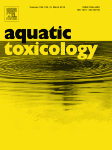Cloning and functional analysis of the ecdysteroid receptor complex in the opossum shrimp Neomysis integer (Leach, 1814)
 In this paper, the non-target effects of tebufenozide were evaluated on the estuarine crustacean, the opposum shrimp Neomysis integer (Leach, 1814). Tebufenozide is a synthetic non-steroidal ecdysone agonist insecticide and regarded as potential endocrine-disrupting chemical (EDC). N. integer is the most used crustacean in ecotoxicological research in parallel to Daphnia sp. and has been proposed for the regulatory testing of potential EDCs in the US, Europe and Japan.
In this paper, the non-target effects of tebufenozide were evaluated on the estuarine crustacean, the opposum shrimp Neomysis integer (Leach, 1814). Tebufenozide is a synthetic non-steroidal ecdysone agonist insecticide and regarded as potential endocrine-disrupting chemical (EDC). N. integer is the most used crustacean in ecotoxicological research in parallel to Daphnia sp. and has been proposed for the regulatory testing of potential EDCs in the US, Europe and Japan.
Major results were: (i) cDNAs encoding the ecdysteroid receptor (EcR) and the retinoid-X-receptor (RXR), were cloned and sequenced, and subsequent molecular phylogenetic analysis (maximum likelihood and neighbor-joining) revealed that the amino acid sequence of the ligand binding domain (LBD) of N. integer EcR (NiEcR) clusters as an outgroup of the Crustacea, while NiRXR-LBD clusters in the Malacostracan clade (bootstrap percentage = 75%). (ii) 3D-modeling of ligand binding to NiEcR-LBD demonstrated an incompatibility of the insecticide tebufenozide to fit into the NiEcR-ligand binding pocket. This was in great contrast to ponasterone A (PonA) that is the natural molting hormone in Crustacea and for which efficient docking was demonstrated. In addition, the heterodimerization of NiEcR-LBD with the common shrimp Crangon crangon (Linnaeus, 1758) RXR-LBD (CrcRXR-LBD) was also modeled in silico. (iii) With use of insect Hi5 cells, chimeric constructs of NiEcR-LBD and CrcRXR-LBD fused to either the yeast Gal4-DNA binding domain (DBD) or Gal4-activation domain (AD) were cloned into expression plasmids and co-transfected with a Gal4 reporter to quantify the protein–protein interactions of NiEcR-LBD with CrcRXR-LBD. Investigation of the ligand effect of PonA and tebufenozide revealed that only the presence of PonA could induce dimerization of this heterologous receptor complex. (iv) Finally, in an in vivo toxicity assay, N. integer juveniles were exposed to tebufenozide at a concentration of 100 μg/L, and no effects against the molting process and nymphal development were scored.
In conclusion, the in vitro cell reporter assay, based on NiEcR-LBD/CrcRXR-LBD heterodimerization in Hi5 cells and validated with the natural ecdysteroid hormone PonA, represents a useful tool for the screening of putative EDCs. As a test example for non-steroidal ecdysone agonist insecticides, tebufenozide had no negative effects on NiEcR/RXR receptor dimerization in vitro, nor on the molting process and nymphal development of N. integer at the tested concentration (100 μg/L) in vivo.
Full reference (link)
De Wilde R, Swevers L, Soina T, Christiaens O, Rougé P, Cooreman K, Janssen CR, Smagghe G. 2013. Cloning and functional analysis of the ecdysteroid receptor complex in the opossum shrimp Neomysis integer (Leach, 1814). Aquatic Toxicology 130–131:31–40.